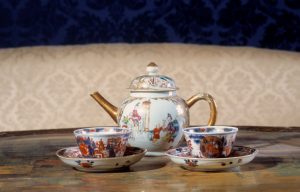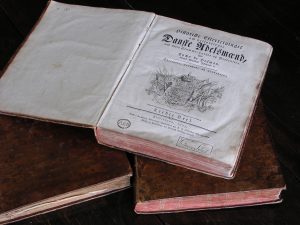Special Exhibition – Tracking Down Europe
Gammel Estrup – The Manor Museum, Denmark, 17 June-22 October 2017
 Globalisation and European community are not new concepts. For centuries, the Danish nobility were closely linked to families of similar rank throughout Europe, and the grand tours of the European nobility throughout the continent spread new ideas and trends. In the fields of both architecture and interior design there was mutual inspiration, and it did not take long for new styles to catch on in European courts and the homes of the upper classes. Overseas destinations were a source of exotic goods such as porcelain and silk for Europe’s upper classes, and gradually both goods and trends spread to even the farthest-flung corners of Europe. Today, as you stroll through the halls and chambers of Denmark’s manor houses, everywhere you find traces of this European history. We find precious porcelain from the Far East, orangeries built to house exotic plants from the South, magnificent clocks from the most brilliant clockmakers in Europe, portraits painted by the leading artists of Europe and lots more besides. The artefacts were acquired over the years, either on the nobility’s travels around Europe or via the widespread network of relatives or friends, which the nobility had throughout the continent.
Globalisation and European community are not new concepts. For centuries, the Danish nobility were closely linked to families of similar rank throughout Europe, and the grand tours of the European nobility throughout the continent spread new ideas and trends. In the fields of both architecture and interior design there was mutual inspiration, and it did not take long for new styles to catch on in European courts and the homes of the upper classes. Overseas destinations were a source of exotic goods such as porcelain and silk for Europe’s upper classes, and gradually both goods and trends spread to even the farthest-flung corners of Europe. Today, as you stroll through the halls and chambers of Denmark’s manor houses, everywhere you find traces of this European history. We find precious porcelain from the Far East, orangeries built to house exotic plants from the South, magnificent clocks from the most brilliant clockmakers in Europe, portraits painted by the leading artists of Europe and lots more besides. The artefacts were acquired over the years, either on the nobility’s travels around Europe or via the widespread network of relatives or friends, which the nobility had throughout the continent.
 In 2017 Aarhus and Denmark’s Central Region have been named European Capital of Culture. To mark the occasion, we are casting the spotlight on the relationship between Danish manor houses and Europe. Throughout the manor house we are highlighting artefacts from the Museum’s collection that reveal the European aspect of Danish manor house history.
In 2017 Aarhus and Denmark’s Central Region have been named European Capital of Culture. To mark the occasion, we are casting the spotlight on the relationship between Danish manor houses and Europe. Throughout the manor house we are highlighting artefacts from the Museum’s collection that reveal the European aspect of Danish manor house history.
Gammel Estrup – The Manor Museum, Denmark